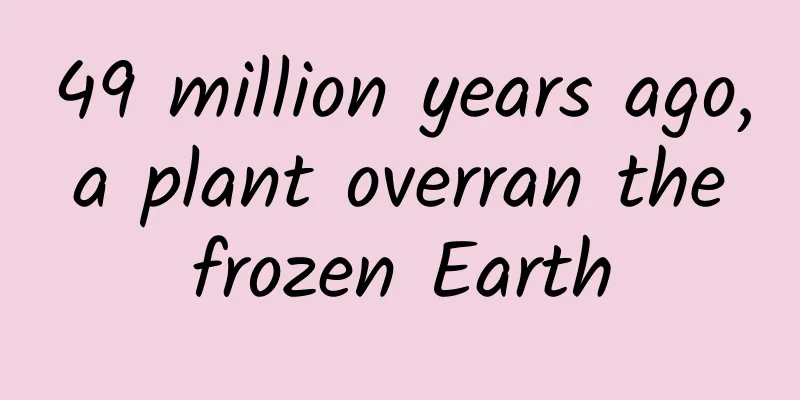49 million years ago, a plant overran the frozen Earth

|
Global climate change has become the biggest obstacle to human health development and future survival. In addition to air pollution and excessive particulate matter in the air, the most serious problem is the impact of greenhouse gases such as carbon dioxide and methane on global temperature. The current carbon dioxide content in the earth's atmosphere exceeds 410ppm, which is equivalent to 0.04%. However, before the industrial age, the carbon dioxide content was only 280ppm. This shows how fast human activities have affected the composition of the earth's atmosphere. In recent years, the lowest temperature in the once cold Arctic Circle of minus 71 degrees Celsius has become history. Now the lowest temperature is 50 to 60 degrees Celsius. In some parts of Siberia, the summer temperature even reaches an astonishing 38 degrees Celsius, which is equivalent to a temperate climate at low latitudes. Due to rising temperatures, the Earth's poles are now facing very serious problems, including melting of ice sheets, mountain glaciers, and permafrost, and constant wildfires, which will release carbon dioxide and methane trapped in them for millions of years, triggering ocean acidification and a more serious greenhouse effect, ultimately destroying the Earth's ecological balance and accelerating the sixth mass extinction event. This is why, on a global scale, humans are now controlling carbon emissions, advocating energy conservation and emission reduction, increasing the development and application of new energy, eliminating backward and polluting production capacity, and trying their best to mitigate the impact of climate change, but this can no longer reverse the situation of climate change on Earth; Therefore, the earth's climate has exceeded the "critical point". If we want to reverse the trend, we must not only stop the destruction, but also pay for the damage that humans have done to the earth over the past decades. That is, to figure out a way to reduce atmospheric carbon dioxide levels to pre-industrial levels. How? The "Azolla Incident" in the history of the Earth may provide us with an excellent idea. "Hong Ping Incident" The "Azolla Event" occurred in the Eocene 56 million years ago. In the early Eocene, the temperature on Earth was much higher than it is now, because the large-scale volcanic eruptions around the world at that time caused the carbon dioxide content in the atmosphere to reach 3500ppm. Such high carbon dioxide levels of course resulted in a very serious greenhouse effect. At that time, there was no ice or snow at the earth's poles, the average temperature reached 23 degrees Celsius, the water temperature of the Arctic Ocean was 13 degrees Celsius, the earth's poles had abundant rainfall, lush vegetation, and were covered with palm trees, which looked more like a tropical rainforest climate. Such a high temperature Earth lasted for millions of years until 49 million years ago, when the "Azolla Event" changed the feverish Earth, turning it into an ice ball, which in turn triggered the subsequent Ice Age. The protagonist of the "Azolla Incident" is a lovely aquatic fern called Azolla, which can now be found in freshwater rivers and lakes all over the world. Azolla is green in color, but its leaves will turn red when it is about to die. Because Azolla reproduces very quickly, the total amount can double in 3 to 4 days, so they often cover the entire lake surface. The bright red color is particularly eye-catching, so they are sometimes called "Red River", and the red in Azolla comes from this. But how can a tiny freshwater plant affect the global climate? Because they have "superpowers". It is also due to the fact that the Arctic 49 million years ago was suitable for the growth of Azolla, which led to the widespread proliferation of Azolla. We know that the current Arctic Ocean is very cold. It is part of the global ocean and has very rich ocean currents. Such salty water is not suitable for the growth of Azolla, but the Arctic Ocean 49 million years ago was not what it is now. At that time, the Asian, European, and North American continents were all gathered together, enclosing the Arctic waters, leaving only a narrow waterway to flow with the oceans outside the earth. This meant that ocean currents could not reach the Arctic waters. At this time, the Arctic was more like a huge "lake" and was very calm. However, seawater is still not suitable for the growth of freshwater plants, so this depends on the rivers on the continents. Because the global temperature was high and precipitation was very abundant at that time, the continents surrounding the Arctic waters brought a large amount of fresh water resources into the Arctic waters, and also brought a large amount of phosphorus and sulfur compounds, which are nutrients that aquatic plants love. In addition, the Arctic waters have no ocean currents and are like a pool of stagnant water, so the incoming fresh water and sea water maintain a state of upper and lower stratification without interfering with each other; The denser salt water sinks to the bottom, while the upper layer is all fresh water. This also causes the salt water at the bottom to be very oxygen-deficient, while the fresh water on the surface is highly oxygenated and has plenty of sunlight. All the conditions seemed designed for the proliferation of Azolla in Arctic waters, and the plant certainly lived up to expectations: it grew quickly, reproduced quickly, and died very quickly. Most of their nutrients come from nitrogen and carbon dioxide in the air. They have excellent nitrogen and carbon fixation abilities, fixing 2.5 tons of nitrogen and 15 tons of carbon per hectare per year. Every summer, Azolla blooms all over the Arctic waters, covering an area of more than 4.5 million square kilometers. In autumn, these plants die in large numbers and sink to the bottom of the sea. Due to the extreme lack of oxygen in the lower seawater, no microorganisms can decompose them. In other words, after the death of Azolla, it did not go through the so-called carbon cycle, but instead sealed up a large amount of carbon in the form of organic matter. Therefore, they store a large amount of carbon in the air and bring it to the bottom of the Arctic Ocean every year, which lasted for a total of 800,000 years. Now humans have discovered more than tens of meters of red azolla sediments on the bottom of the Arctic Ocean, which also verifies the authenticity of the red azolla incident. The impact of the Azolla event on the Earth's climate was enormous. Over a period of 800,000 years, it caused 80% of the carbon dioxide in the atmosphere to disappear, and the carbon dioxide concentration dropped from an astonishing 3,500 ppm to 650 ppm. The temperature at the Earth's poles, which were then experiencing a tropical rainforest climate, dropped to -9 degrees Celsius. The Earth's poles began to freeze, and the Azolla event was one of the catalysts for the next ice age. Can Azolla save humanity? The current carbon dioxide level on Earth is 410ppm. To return carbon dioxide to pre-industrial levels, that is, to reverse human-caused climate change, carbon dioxide needs to be reduced to 300ppm. On average, Azolla events reduce global carbon dioxide by 0.0035625% per year, which means it would take 30,877 years to reduce 410ppm to 300ppm. It would take 30,000 years for the fastest cooling event in Earth's history to offset 70 years of human carbon emissions. This is enough to show how powerful humans are, how fast our Earth's climate is changing, and how difficult it is to reverse this change. But that doesn't mean we can't change the future. Humanity can continue to reduce carbon emissions and strive to minimize them, and then use Azolla to neutralize annual carbon emissions and strive to control the concentration of carbon dioxide below 450ppm. If we can replicate the Azolla event and neutralize CO2 emissions, we can reverse climate change! But there is still a question: can we really replicate the Azolla incident? Unfortunately, there is no place in the world today that is quite similar to the Arctic 49 million years ago, and we can no longer enclose the oceans, nor can we destroy the oceans and affect their biodiversity. So we can only choose freshwater lakes on land. The Palearctic Ocean has an area of 4 million square kilometers, which is slightly larger than the Caspian Sea (371,000 square kilometers), the largest lake in the world by surface area. We can increase the surface area by adding a smaller lake, such as Lake Malawi, which has an area of 29,500 square kilometers. If we use these two lakes, we have enough surface area to replicate the Azolla event. By artificially transforming these two lakes into breeding grounds for Azolla, the efficiency of Azolla in absorbing carbon dioxide will far exceed that of Azolla in history through artificial cultivation. It will be enough to balance human carbon emissions and control the earth's temperature in the future. However, this approach would require a huge price, such as sacrificing all the creatures in the two lakes. Transforming the lakes would be a huge investment that would require participation from the entire world. Humans will not do this unless they have no other choice. But this also provides a way for humans to save the earth in the future. Source: Cosmic Decoding |
<<: A look into the 2022 Nobel Prize: How did humans come into being?
>>: China Qiu Shui Map is here!
Recommend
Fan-shaped ears, long nose, what you see is just my appearance
Today I want to share with you the story of the n...
If you don’t know how to flirt with girls, you don’t know how to promote a brand
If there is anything in common between business a...
Why does Microsoft's holographic glasses HoloLens stand out?
January 25 news, Microsoft has a vision for the f...
The Secret of Love and Sex——25 Psychological Lessons for Understanding Intimate Relationships [Complete]_Sharan Hancock
The Secret of Love and Sex——25 Psychological Less...
Can header images also increase open rates? It's not impossible!
The backend revisions can always be adapted to, a...
Apple App Store’s latest review rules in June! It is said that everything has changed!
After the WWDC2016 conference, Apple released fou...
Solutions to Xiaohongshu account weight and note flow limit!
Today I will talk to you about the questions that...
How to plan a public relations event?
How do PR activities affect brands? Organizing a ...
Is it that the personalities of husband and wife are becoming more and more alike, or are people with similar personalities more likely to become partners?
© Anna Breit/Connected Archives Leviathan Press: ...
How to reduce the harm when you have to drink? Remember these 13 points!
Alcohol is a love-hate relationship for many peop...
Is there a bug in a $10 bayberry?
This year, the plum rains in the south lasted lon...
If you accidentally swallow gum, don’t worry, it will be fine in a week!
When I was a child, the two most common lies I he...
From DHT to DM-i, how attractive are the hybrid technologies of BYD and Great Wall that are frequently released?
For many years, when we talk about hybrid technol...
How to build an overseas operation and promotion system from 0 to 1!
Preface: Many Chinese Internet startup teams goin...
After a bad start, where will Huawei and Xiaomi’s PC journey go?
A year later, Huawei launched the second generati...









